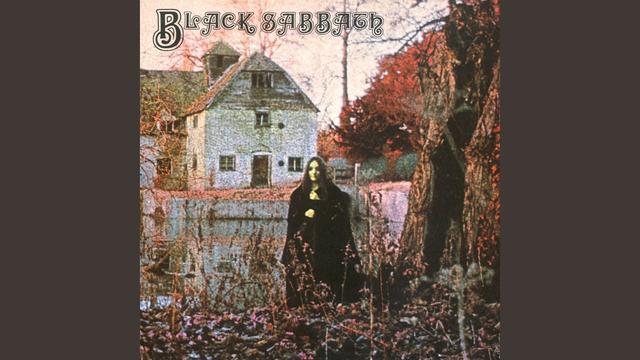
Sometimes it happens that individual songs contain other songs - songception, so to speak. For this music-theoretical structural form, there are various possible approaches and implementations for acoustic professionals. Sometimes different parts are divided by pauses, sometimes the changes in key or tempo are so marked that the musical break is drastic enough to be understood as a title change. As befits the standard, the borders are also fluid here.
Many of these tracks can be understood as a medley; some are even marked as such. By definition, these are musical pieces that consist of several independent compositions. This definition also applies to the following songs. However, many of the tracks on this list are shaped in a more unconventional way than you might expect from classic medleys. Accordingly, these titles form an incomplete compilation of songs, which could actually be several.
Black Sabbath's "Warning"
Warning is the seventh track on Black Sabbath's 1970 self-titled debut album. "Now, the first day that I met ya/ I was looking in the sky/ When the sun turned all a blur/ And the thunderclouds rolled by". With this album, the Birmingham-based band, fronted by Ozzy Osbourne, paved the way for a genre known for heavy distortion and fuzz, for power chords like cranked tube amps.
As for Osbourne, it's hard to tell now if he's better known to mainstream audiences for the legendary performance in which he bit off the head of a bat, or for his absurd reality TV show that aired on MTV in the early noughties. He and his family gave insights into their own private lives and within a very short time became world-famous personalities outside of the music world and also helped to invent reality TV. Above all, however, the band is a rock in terms of music history: probably every group that is prescribed somewhere between doom and thrash metal to this day will probably name Black Sabbath as an influence.
"Warning" begins with a sluggish drum rhythm, lots of sluggish cymbal hits and distorted guitar riffs by Tommy Iommi. The first part of the song ends at a good three and a half minutes, Osbourne falls silent and Iommi now sets the tone. Then: break? There is a brief silence, which finally introduces a fading outro with a guitar solo, until shortly before seven minutes the blues begins. At this point at the latest, the first part of the long jam is left behind completely - Black Sabbath also marks the undisputed insertion here by changing the key.
Shortly before the end, the tide is turned around again, at nine minutes and twenty seconds the song maneuvers back to the actual track, a cover by Aynsley Dunbar. The virtuosic, minute-long drifting should not only be groundbreaking for various later bands, but maybe also for one or the other from this list.
A prime example of what it can look like when artists wrap multiple songs in one box. In this case, the break could refer to the provenance of the original. Because as already mentioned, "Warning" is actually from the Aynsley Dunbar Retaliation. However, Black Sabbath's version was stretched by a good seven minutes - the second part of the song remains exclusively instrumental and is therefore all the more its own who than just a mere cover.
By the way, the chorus of the Black Sabbath title says: "I was born without you, baby/ But my feelings were a little bit too strong". Ozzy Osbourne is said to have misunderstood the lyrics of the Aynsley Dunbar Retaliation, because the original says: "I was warned about you, baby."
"The Change" by Felt
Admittedly, little is known about the US band Felt. In the late '60s and early '70s they got together and started making music in the desert rock area on the border between Tennessee and Alabama. Myke Jackson (guitar), Mike Neel (drums), Tommy Gilstrap (bass), Allan Dalrymple (keyboards) and Stan Lee (guitar, not to be confused with the comic artist) formed the band together and created exactly one album: It was also self-titled " Felt” published in 1971.
The Change is about a revolution. "Well things were changing slowly/ And everybody knows that this ain't helping anybody/ We want some changes fast/ So we can leave the past". Myke Jackson describes the urge for change and the result of that circumscribed revolt - but one does not learn a clear motive or a desired result.
Felt increases the complexity and offers at least two, if not three separable pieces with their song “The Change”, which is over 10 minutes long. The band sometimes serves crunchy, blues-based rock, sometimes they drift into beatlesque psych rock. Razor-sharp guitar solos, fresh organ sounds and raging drums. If you drive along the coast on a warm summer evening with your sunglasses on, this track will automatically play on the car radio.
"Sing About Me, I'm Dying Of Thirst" by Kendrick Lamar
In hip-hop, a similar phenomenon, which was first dubbed "Songception" here, is now known as "Beat Switch " known. Although this describes the change in composition within a piece somewhat more clearly, it is also characteristic of the style of this genre. At least something like that, because with the Beat Switch the beat changes; in the middle of the track. Perhaps across genres it could be better called “Composition Switch”. In the subcultural space, this mainly comes from producers, but is also becoming increasingly popular with artists. The nature of the compositional changes is not always congruent with those from which this list was drawn up – but sometimes it is.
With titles like "Sing About Me, I'm Dying Of Thirst" Kendrick Lamar has already provided a foretaste of his next records in 2012 on "good kid, m.A.A.d city". The concept album "To Pimp a Butterfly", which followed three years later, is dripping with jazz influences and mixes genres in an unconventional and extraordinary way. The self-proclaimed “outtakes”, which didn't make it onto the Butterfly album, ultimately resulted in “untitled unmastered”. According to unpopular opinions, Lamar's best album.
"Sing About Me, I'm Dying Of Thirst" begins with that jazz drum motif that's not out of place but unexpectedly playful. With this track, the boundaries to the "song within a song" blur a bit, but you shouldn't judge the work by that. The second part starts at around 7:20 minutes and is clearly separated from the previous part by a break. From now on, Kendrick Lamar preaches for almost three minutes at a time. You could call it a very long outro, or you could put "Sing About Me, I'm Dying Of Thirst" on this list. But because the first part is also quite playful despite the "Beatles scheme" - ie verse, refrain, verse, refrain - the latter option should be more than justifiable.
Also on the same album is "m.A.A.d city" which also deserves a notable mention on this list. The party track ends abruptly after two minutes and 30 seconds and instead takes a completely different direction. A prime example of a beat switch. The second part is also significantly longer, which makes it the actual main part.
On "good kid, m.A.A.d city," Kendrick Lamar tells the tough yet confidence-shattering story of a decent "kid" trying to find his own way in the midst of urban madness. In the midst of a mad city steeped in all of society's vices, this album-length tale culminates in "Sing About Me, I'm Dying Of Thirst" of sorts: a reflection on the conditions in the urban ghetto of Compton, a borough of Los Angeles, where Kendrick Lamar grew up.
Relationships are described that drive people to desperate actions. Racism, a lack of state support and unsuccessful integration drives residents to crime. Not a self-chosen path, but pushed to it by external circumstances. Drugs, prostitution, violence - an innocent child is growing up here, who didn't choose his environment himself and yet has to learn to deal with it.
"In Search of Time" by Love Machine
Having emerged from the wild German West, Love Machine embarked on a psychedelic journey into the inner circles of their own being with their debut album "Circles" in 2017. "With Times to Come" it was clear that something would follow: the step back to one's own roots. Her third work "Düsseldorf-Toyko" finally connects home and far away on several levels and creates one from them. In Japanese architecture, aesthetics often do not lie in the completely new; instead, the new seeks a connection to the tried and tested.
That's how Love Machine draws the line to their musical work. After two previously English-language records, Love Machine return to the roots of their own mother tongue. German and English mix throughout the album and especially within individual songs. "Düsseldorf-Toyko" has also detached itself somewhat from the dreamy psych rock sounds, but has never forgotten this origin. Similar to Düsseldorf, where one of the largest Japanese communities exists outside of its own country and features parts of the cityscape.

The last track of their debut album "Circles" is even more reminiscent of the dreamy psych rock genre that had its heyday in the 60s and 70s. Cautious trumpet sounds introduce the record's finale, which deserves its place in this list at just over four and a half minutes: Love Machine kicks off the second chapter of "In Search of Time" with massive wah pedal support. Six minutes of powerful psychedelic jazz thunderstorms follow.
"The Bob" by Roxy Music
In the undisputed masterpiece Baker 3, which has drawn kids to established skate shop sofas for decades - and hopefully still does today - strums "The Bob (Medley )” by Roxy Music in Andrew Reynolds' part. The full-length video from 2005 is a milestone in skateboard culture. The featured song "The Bob (Medley)" is a track written by Bryan Ferry and recorded with Roxy Music, which appeared on their 1972 self-titled debut album.
And as the title suggests, "The Bob" is a medley. Roxy Music spoils in advance what listeners can expect from this track. However, this medley is not entirely conventional either and thus perhaps falls more into the “Composition Change” category.
The title of the song is an acronym for "Battle of Britain". During the Second World War, more precisely between the summer of 1940 and the beginning of 1941, after the victory over France, the German Luftwaffe tried to force the surrender of Great Britain with attacks in British airspace. The resulting air battle was a series of engagements fought by the German Luftwaffe against the British Royal Air Force. The shots and explosions of the battlefields can be heard in the instrumental break.
These battle noises introduce the second part of the song. "Too many times beautiful/ Too many times sad". Different: The insertion of a refrain-like part with a guitar solo, followed by the psych rock verses of the first few minutes later. A classic - if you can even call it that - division into two different song sections is missing here. But as already clarified, the borders are not always clearly defined. That's what makes the track so interesting and probably why Andrew Reynolds does frontside flips on it.
"Empire Ants" by the Gorillaz
You can hear on "Empire Ants" what it sounds like when two clearly different tracks merge into one another within one title. He compares the goings-on of mankind with the orderly march of an ant kingdom, which is often only held together by anticipating the steps of an insect running in front of it. Each ant, as part of the big picture, is driven by its own desires in the (near) distance and encouraged to keep walking. "Working on the machine".
The first part of the story, which is told allegorically in the song, deals with the few opportunities in life where you can shift down a gear. To stop, take a deep breath and look at the ant kingdom from the outside. In those moments we see the world as it really is because we have the objectivity and find peace with ourselves apart from the system.
But then comes the classic "Monday" and we march on. This break is also formative for the piece, which is now different. With Kavinskyesque musical accompaniment, memories blur and everyday life goes on. "Little memories, marching on/ Your little feet, working the machine". The surreal moments of clarity and quiet harmony are over.
A collaboration with Little Dragon, "Empire Ants" and "To Binge" are two of the most elusive and mysterious tracks on "Plastic Beach", which also features Gorillaz hits like "Rhinestone Eyes" and "On Melancholy Hill".In an interview with NME, Murdoc Niccals (bass) explained that the song is "a moment of calm in the midst of the hustle and bustle. I sampled a lot of it from the theme music of 'Tomorrow's World' and the vocalist is Yukimi Nagano from Little Dragon, a Swedish electronic band. Actually, it was 2D [lead vocals and keyboards] that drew my attention to Little Dragon. He played me this beautiful song of theirs called 'Twice' which he first heard on the TV series Grey's Anatomy."
"In the Court Of The Crimson King" by King Crimson
If there were a podium in this list, King Crimson would be at the top. As is well known, tastes can be argued about. But not about quantity: Because with their album "In the Court Of The Crimson King" from 1969, the US band created the excess of a song structure that was previously jokingly called "Songception". Accessories are incorporated into four of the five tracks on the record. Two out of four are even double expansions.
King Crimson's debut album "In the Court Of The Crimson King" is already considered groundbreaking in progressive rock, but the band's work also had an influence on many records of the 70s across genres. Even in 2010 it's still being sampled to a high standard: Some will recognize the refrain from "21st Century Schizoid Man" - Kanye West incorporated it quite prominently in the song "POWER".
Chromatic sequence of notes, time changes, up-tempo jazz rock and a musical end to a time that is now associated with both "Peace and Love" and social unrest - lyrically, some lines evoke that dystopian future that is strongly approaching reminded of the unstable decade change. "Politicians' funeral pyre/ Innocents raped with napalm fire".
It is said that the decision to use songs in the songs - which are also marked as such in the titles - was a pure PR decision. Song five, for example, is titled "The Court Of The Crimson King ([Including] The Return Of The Fire Witch and The Dance Of The Puppets)" because management would have stated that the album would sell better if it ended up with more songs would stand on it.
In the single version of the tracks as well as on older (additional) material or included in deluxe versions, the inserts like "The Dream" and "The Illusion" in "Moonchild" are missing anyway. That's why it could almost pass as a composition switch album, if only the mystical ballad "I Talk To The Wind" would also contain an additional song. It's the only track that doesn't have "Including" in the title.
The hallmark of the album is undoubtedly "21st Century Schizoid Man" - the first track on "In the Court Of The Crimson King". Some of the cornerstones that would later lead to subgenres like desert rock or doom can also be seen in the piece's sluggish and sustained riff. The song contained in the song "Mirrors" depicts the tense situation of that schizoid person of the 21st century - a jazzy guitar riff that is repeated at breakneck speed and partly incoherent rhythms and sonically depicts the psyche of the drawn figure.
"Who?" by 2LADE
Who?? 2LOAD. Pronounced "Blade", playfully in his lyrics sometimes like "too late". The Cologne artist uses grime from Great Britain – musically based on this genre, there is no lack of Nike outfits or dangerous-looking boys in underground garages. Suitable for the deep growling voice of the rapper. But 2LADE has another special feature: The character that he creates in the public sphere and with his videos is - as his name might suggest - based on the comic character Blade, which exists in the Marvel Universe. He's a vampire hunter and half a bloodsucker himself.
1998 saw the release of the first installment in the eventual Blade trilogy, starring Wesley Snipes. Luckily long before the Marvel franchise flooded the cinemas with rubbish, because the first part is - as trashy as it was then and even more so two decades later - the finest entertainment of the splatter genre. Think of the scene where Snipes walks through a club full of techno half-deads until it finally rains blood and floods the room by the cubic liter. 2LADE consciously plays with this role and lets it flow into social networks like his texts.
With “WER?” 2LADE demonstrates that two songs can also be accommodated in three and a half minutes. By the way, the first part was shortened for streaming platforms. Perhaps because the typical listener's attention span doesn't extend beyond the first part of the track. As a music video, "WHO?" can be heard in its entirety.
2LADE also uses an old German rap single by B-Tight in the chorus, which was probably sung in canon in front of every coffee table in Germany covered with chips and iced tea at the end of the 2010s, mainly because of its absurdly low level of trash.
Due to the external circumstances, the first part of the track might be understood as an intro. But it has too much structure of a complete piece for that. Sure, a minute for an intro isn't half a song, but with a total length and an algorithm-friendly average length of something like two minutes, it kind of is.
"GLOWED UP" by Anderson .Paak + KAYATRANADA
Another example that corresponds to the beat switch in its composition: "GLOWED UP" again has a fluently introduced break in the song, who shares the song after a good three minutes. The party anthem will probably be changed at the club here. The second part of the piece is probably also danceable, but “GLOWED UP” slides from a bass-heavy movement trainer to a dreamy jazz-rhythmic eye-closer.
Glowed up is a (slang) Anglo-American idiom that describes a drastic change for the better. For example, the ugly duckling has become a beautiful swan. Anderson .Paak was briefly homeless with his wife and child during the early days of his musical career, and today he is a multi-millionaire. KAYATRANADA delivers the instrumentals that let you feel the euphoria peppered in your face with the lyrics. At first glance it may be the classic "Fat Eggs" rap vocals, but who can claim to embody "started from the bottom now we here" in such a way?
Without reference to the first part, everything is discarded and something new is created with the second section. Two minutes of outro or a new track? Perhaps. matter of opinion. But what speaks against not being able to pack two songs into one and breaking through pop conventions such as prescribed commercial schemes?
Honorable Mentions
A classic medley would be "Aquarius/Let the Sunshine". In by the Fifth Dimension from 1969 - perhaps the most successful medley in pop music - or "Somewhere over the Rainbow / What a Wonderful World" by Israel Kamakawiwo'ole.
The British prog rock band Camel is once again taking a somewhat more unconventional approach - even if the title even names the medley in some versions. Classically in the style of progressive rock, the implementation is closer to King Crimson or maybe Felt from this list and delivers so many different compositions in 12 minutes that you lag behind with counting.
A$AP Rocky also created a track with the help of the present Moby sample, Porcelain, which deserves to be named here. "A$AP Forever" takes various parts of the original and builds its reinterpretation into two acts. Here, too, the piece in the music video differs from the pure audio file on streaming platforms or physical copies. By the way, the music video is a masterpiece, but unfortunately restricted on YouTube due to an age rating.
Also Travis Scott's SICKO MODE with Drake would have been a good example of a "beat" aka "section switch". At least from a music-historical point of view, because the track, in the roughly titled hip-hop genre, has ensured that more and more producers and artists are taking the unconventional path of compositional changes. But since the track really isn't good, it's only enough for this brief mention - on the list of retitled "Composition Changes". Songs that could actually be several.







